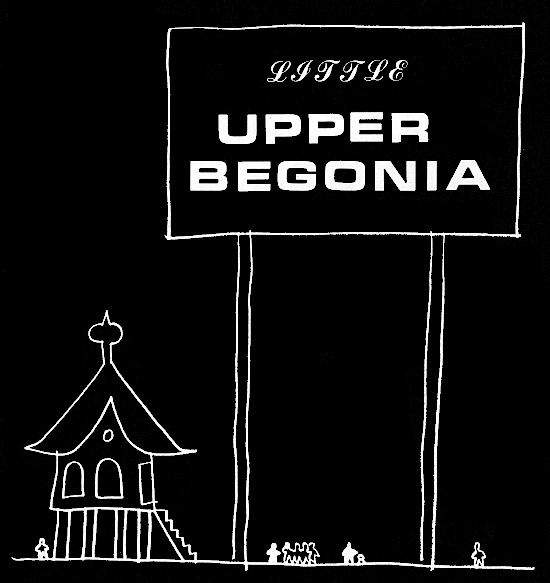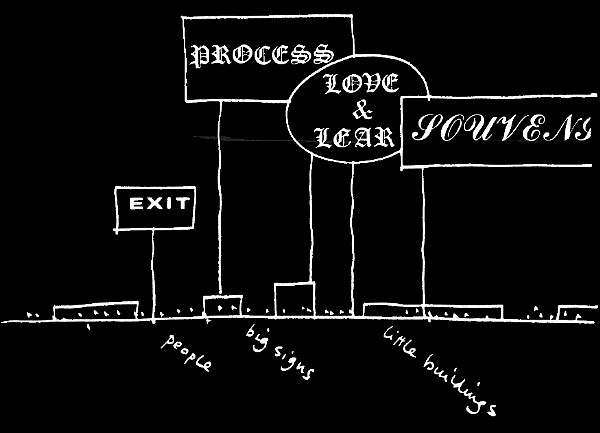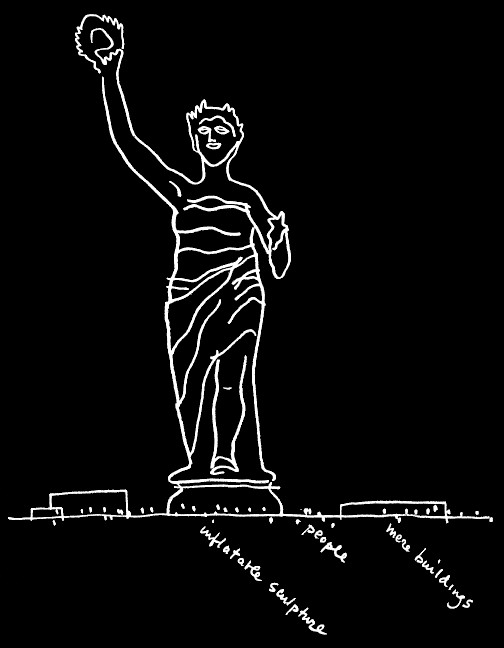"The Bicentennial Commemoration 1976"
Denise Scott Brown and Robert Venturi
The Architectural Forum, October 1969
See also: The Benjamin Franklin Parkway Celebration for 1976
| |
International Expositions and Fairs offer the world an amalgam of national aspirations, economic boosterism, gaudy self-aggrandizement and innovative architecture. Recently added to these have been high-sounding themes that begin "Man and . . . ," and a concern on the part of city fathers to use these occasions to manufacture urban real estate for later sale to developers. What remains of an Expo after a hundred years is some feeling for an epoch--what 1851 or 1939 felt like--and some landmark structures, like an Eiffel Tower or a Crystal Palace, known for their influence on the history of architecture.
Ours is a different age: non-heroic (the antihero is our hero), non-universalist, anti-architectural. It is significant that Expo 67, hailed as a triumph, produced little innovation in architecture or structure. The idea of Habitat is more than ten years old and Buckminster Fuller's beautiful dome more than twenty. The most successful exhibits at Expo 67 were movies, particularly those in the Czech pavilion. People flocked to them. McLuhan was right. The theme "Man and His World" rang empty, as did the Brussels Expo theme, and it was not by the theme pavilions that the subtle spirit of an age was conveyed.
How much more different at this divisive point in our history for American to talk of Man. We shall be castigated by the nations of the world as Frantz Fanon castigated the Europeans: "They are never done talking of Man, yet murder men everywhere they find them."
House in Order by 1976
This is not the time for Americans to talk of universal aspirations, nor even of great world problems. Too much is wrong at home. It will look like an evasion of the issue. We have a war here against social injustice, poverty and prejudice. Themes for today should be specific, immediate and urgent, like a letter from the front. If by 1976 we cannot present to the world a war half won, then we should be ashamed to commemorate the Bicentennial. If, on the other hand, we adopt the modest theme of "House in Order by 1976" with the stupendous task it involves, the nations will flock to our shores in that year both to see and to help, and we shall earn from the world a respect that no amount of foreign aid or military strength could command. Without fanfare, the universal meanings will emerge: America and the world are "men" not "Man," and it is good to live in a pluralist society.
In such a celebration social innovation would overshadow architectural innovation. Governments would cut their construction costs and send people instead. Major creative effort would go to the design of social happenings, situations and experiences, to bring together people of many nations in memorable discourse. Since we would be inviting people, and hopefully not only "leadership people" and the "masses," we would become sophisticated on the notion of groupings and the nature of pluralism. The word "mass" would become fleshed out to reveal its dimensions; the sociology of groups would receive a great boost and the group therapists and social psychologist might become the great designers.
Now is the time to call for ideas on social innovations. The design of social experience is a new field. Anyone can help. Ideas should be sought from school children, burlesque show producers and garden party hostesses, from labor arbitrators, foundations heads and bus drivers. People throughout the world should be asked to fantasize "Wouldn't it be nice if . . ."
Wouldn't it be nice . . .
. . . if different nations were invited to send a school to the Commemoration, each with all its teachers but half its children, the rest coming from America. We have all had some schooling; we would all enjoy sharing, through our children (and some complex electronic display systems) the experience of education in Nepal or Norway.
. . . if non-convention-going groups, those outside the professions and upper classes, who seldom travel, were invited to the U. S. to meet with their U. S. equivalents: international conventions of fitters and turners, shoestore employees, cafeteria waitresses, institutional janitors, apprentice plumbers, seventh grade school children.
. . . if the nations of the world were respectfully asked to demonstrate the mechanisms they have evolved for dealing with dissension and diversity and for aiding the poor.
Architecture and urban planning
With no more Crystal Palaces, Eiffel Towers, Atomiums and Habitats, where would this leave the architects and planners? Still very much employed and perhaps even more challenged, since now their ingenuity would be taxed to make much out of the little available for building, to make meaningful in built structures the serious aims of the nation, and on top of this to make our show fun, seductive and delightful.
Because our needs are serious, and built commemoration should do as much for the city or cities where it is located as possible. Since most of the commemorative activity and building will probably happen in center city, the caveats against urban renewal as a destroyer of the habitat of the poor apply here. But more than this, alternative schemes should be judged by the degree to which they provide jobs and opportunities for low-income local residents; also, if there is to be an historical commemoration the ghetto should get its share. Its historical buildings and places should receive special attention and the Expo exhibits on black culture should be located in the rehabilitated streets and buildings of the ghetto. Low-income shopkeepers and entrepreneurs should be helped to take economic advantage of the Commemoration as the rest of the city will be doing. Vocational schools for management and skilled positions in the hotel, catering and other tourist-related trades should be opened in ghetto areas of eastern cities now in preparation for the Bicentennial. The Commemoration should serve, starting now, as a major aid to economic development of the black community, otherwise we shall have little to celebrate in 1976.
Other nations should be invited to help the chosen U. S. city or cities with systemic renewal, for example, of public transit: a bus line to the standards of and with the signs and shelters of London Transport, and subway stops renewed by and in the style of famous subway systems--Milan, Moscow, Montreal--could be part of the exhibit. The whole garbage and clean-up system of an eastern city could be overhauled by a European city or by Los Angeles. A whole Expo-related learning system could be introduced, based on coin-operated learning machines where you find other coin-operated machines in and around public transit, shopping centers and waiting places--"Learn while you ride," "Shop and learn."
The 1976 deadline should be used as a goad for the development in U. S. cities of serious housing policies, and also as a means for aiding the black and Puerto Rican populations to leave the centers of old cities and make for the suburbs with the rest of us. This calls for a new look at suburbia, and for an overall strategy for low-cost housing, across city and county lines from central areas to outer edges, related to job opportunities and commuter lines. And it calls for a change of heart in suburban communities. If, in order to build low-cost housing, it must be designated first for Expo tourist, well, so be it.
The present preference among Expo planners for "theme pavilions" over national pavilions--with participants asked to provide theme exhibits within host-designed exhibition space rather than to send national exhibits of their wares for national pavilions--is, we believe, misplaced. We should use our Expo to face our urban problems: in this case the problem of freedom and control in the visual landscape. By admitting rather than excluding the individualistic national and commercial pavilions as part of the traditional excitement of Expos, and incorporating them into a complex order, like that of the city itself, we might learn techniques for the control of the commercial environment less coercive than the controls we now use. Las Vegas (and we are talking purely of the "crass commercialism" of its roadside architecture, not of the pros and cons of gambling) could make an excellent model for a 20th-century Expo.
Against technology
In the last two Expos, the U. S. has been content to let its industrial and technological might be illustrated on the road to the fair. Inside we were selling non-aggression and simple joys, Hollywood and Raggedy Ann. The satellites up in the Montreal dome were a foreign note, toned in with the rest through their beautiful Op parachutes which hovered above from the ceiling. Why should Little Upper Begonia strive to show us its plastic factory when it has so much to say on the harnessing of teen-age revolt or on the housing of rural migrants? Demonstrations of industrial might are a hangover from the World Fairs of the 19th century. Demonstrations of avant garde technology are exciting and popular but seem out of keeping with out present need, which is to use the technologies we have to solve social problems. The great technological innovations we should be demonstrating in 1976 are ways of meshing the relative simplicities of scientific systems with the messy unmanageableness of social systems. We need scientific methods for dealing with uncertainty, chancy models for risky deals, one-of-a-kind programs for one-of-a-kind people. We need great strides in organizational technology rather than in industrial and manufacturing technology. In architecture and planning this means forgetting our futuristic, space age fantasies and concentrating on organizing what methods we have, to build for the poor rather than against them and to combat the public squalor and decrepitude of our cities.

Against megastructures
The urban problems, the problems of sprawl city and the problems of freedom and control will be evaded if we accept for our Expo the "megastructures" that are fashionable in urban design today. These medieval hill-towns with their avant garde trappings are the resort of architects who can't deal with the city on its own terms and turn with nostalgia to the simpler cities of earlier ages, and to the futuristic imagery of the space age. Megastructures may be suited to some dense central areas but they are not relevant to our important urban problems: the poor are priced out when such intense development occurs on their doorstep, and sprawl city is more interesting than the megastructure. The megastructure is a European importation. Just now the Europeans are turning to America to learn of another city, the process city, the difficult whole where to order is not easily apparent. This city--Los Angeles or the suburban fringes of eastern cities--is increasingly the reality to be faced here and in Europe. It is the real area for physical innovation. The megastructure is not relevant to it.
The megastructure, designed by an individual or team, is often called by its proponents a "total environment," where unitary control of design brings harmony, and where "crass commercialism" and other ugly intrusions on the part of individuals can be excluded. It is not a good prototype since this degree of control is patently unattainable over most portions of most American cities and, as Expo 67 showed, cannot even be achieved at Expos. Even if it were attainable it is not desirable, since it produces that deadness of environment demonstrated by most U. S. urban renewal projects and many European new towns. And the local population, unimpressed by the praise in the architectural magazines, stays away in droves. The people should have a say in the making of the Commemoration. Even if this makes it untidy, it will at least be lively. It should not be the child of the egos of one, two or three "great designers."
| |
Against "human scale"
So the Crystal palace and the Eiffel Tower should not be followed by the Megastructure.
On the other hand, the "human scale" or "townscape" approach to urban design should also be watched with care, since a mass audience has mass needs which, if met at too "human" a scale (say at the scale of campus planning or of Expo 67) cane lead to quite inhuman conditions of overcrowding. Architects are not accustomed to the problem of the design for mass use. It calls for simple, easily understandable site plans (see Disneyland) with great consistency in the location of service areas, toilets and transit stops; with highly scientific signing systems; large overflow spaces adjacent to crowded areas and large spaces at points of decision in the movement flow. This just for a beginning.
Mass use demands, too, a rethinking of interior display systems. Low objects and small screens cannot be seen by the kinds of crowds that waited three hours outside the main pavilions at Expo 67 then moved through the show in phalanx, ten abreast. They need a flat, safe walking surface and exhibits above their heads. There is some question whether real objects should be exhibited in such situations or whether they should be kept for eddies and backwaters, and the major exhibits be movies, lights and electronics. And if movies, why not multiscreens? A movie, unlike a stage performance can be shown in many places at once, so why wait three hours for it? Why not, at least, place closed circuit TV along the waiting lines to show what you would see inside if you waited? Why shouldn't the line itself be the exhibit? And for the mass audience, the more electronics and celluloid and the less reality, the better.
But perhaps the answer is to spread the celebrations between different sites and possibly different cities linked by the refurbished movement systems and the communications media. Then points of connection and intense interaction at interchanges on the movement system would become points of exhibition and communications.

Communication architecture
Communication is particularly important when we stress social innovation over architecture. We recommend, because of the social tasks, the use of modest buildings with big signs. An Expo based on interaction of people in meeting places spread over several cities could look a little low. It would resemble the long, low buildings of the roadside commercial landscape and the suburban supermarket, and we architects shouldn't fight it. Rather, we should do as they do, and augment our architecture with signs; great signs, over the heads of the crowd, welcoming them in many languages and in visual language, orienting them in the vast space of the fair ground, beckoning to them on the freeway and subway. Signs saying LOVE and LEARN, signs describing the exciting process going in the modest buildings below. Signs designed by artists, engineers, sign-makers and school children, but located carefully with due regard for the science of perception. Competitions could be held for the design of copy and new signing systems. We might do more for urban beautification through the development of sign technology and a public interest in signing than by antibillboard legislation. And architecture shouldn't try to compete. The contortions we indulge in, in our architecture for the sake of civic grandeur or commercial splendor, are an ironic distortion of our functionalist doctrine. We eschew applied decoration--that's not modern--but we deeply distort whole buildings for the sake of expression. Leave that to the signs! "Pure" architecture just isn't suited to be a medium of expression on the freeway or on the freeway through our lives. Don't strive to make Expo architecture be what it can't be today. But still allow the individual nations and organizations their garish autonomy because their pavilions are, in their own way, sign posts. And let there be statues of Lincoln, Lenin or Lumumba 27 stories high--inflatable.

The public structure
In all this cacophony, the public structure--what the U. S. and the host cities have to offer--should be the controlling element. The public spaces and public services--movement systems, streets, waterways, refreshment and service centers--should be tough, solid ample, familiar, conventional and kickable. They are the friendly base for all the variety. Their design and spacing should be simple, consistent and understandable. Their signs and symbols should sharply contrast with the cultural and commercial communications.
What else should be in the public domain in addition to utilities and services? Perhaps sculptured terrains, shaped to take the baroque flow of moving crowds and to connect with the private and public-private realms. Perhaps the contribution of the host city to the public domain should be weather protection and air conditioning against our eastern summer. Between the public and the private should lie and inbetween realm, for the meeting places and joint ventures between us and other nations.
The relations between all three realms should be clear and clean, the divisions well demarcated, the entrances well signed. No one should get stuck for an entrance or lose the exit.
Authors' note:
We owe much in the development of our ideas to Mr. Tom Wolfe (who coined the phrase "electrographic architecture"), to Mr. David A. Crane, to members of the Philadelphia Bicentennial International Exposition Planning Group, and to the Philadelphia Citizens' Committee to Preserve and Develop the Crosstown Community, and all their advisors.
|


